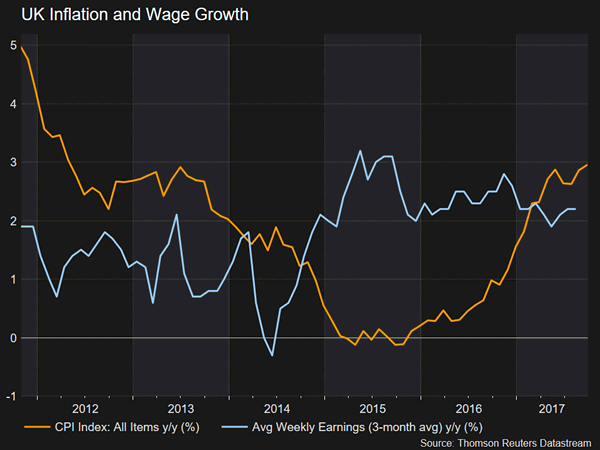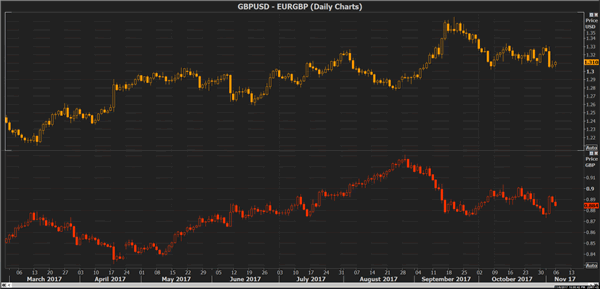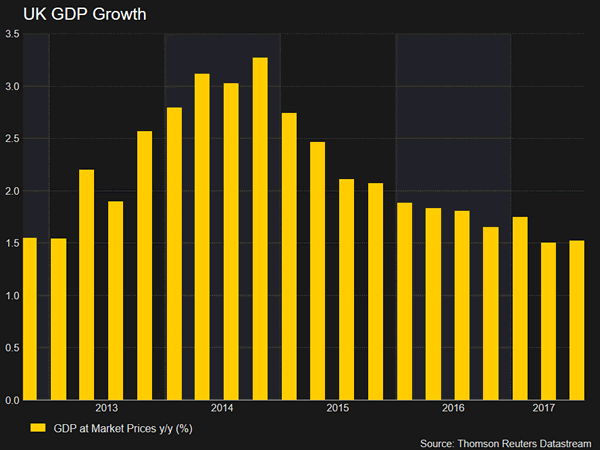The UK economy’s resilience to the Brexit vote did not continue into 2017 as largely upbeat economic releases following last year’s vote did not manage to maintain momentum with economic activity eventually slowing down. Meanwhile, June 2016’s vote shock led to sterling depreciating versus other currencies, pushing inflation higher.
Inflation is growing at a faster pace than wage growth resulting in consumers’ reduced purchasing power. This is negatively affecting spending patterns.

The Bank of England proceeded with a rate rise for the first time in over a decade upon completion of its November meeting on monetary policy in its efforts to push inflation lower towards the central bank’s target. However, the central bank faces important tradeoffs: is it wise to raise rates in an environment of declining economic activity?
Adding to the challenges, politics go beyond Brexit-related uncertainty after Prime Minister Theresa May’s Conservative Party failed to maintain its parliamentary majority following the elections that took place in early summer. On top of that, her leadership is challenged, further complicating the situation and acting as a drag on the pound.
Bank of England balancing act: inflation Vs risk to hamper economic activity
The BoE decided to raise its benchmark rate by 25bps to 0.5% as its complemented its latest policy meeting. However, just as markets interpreted the European Central Bank’s tapering decision earlier in October as relatively dovish, the BoE’s rate rise was also dubbed as a "dovish hike" with sterling recording sizable losses relative to majors including the dollar and the euro.
Given the BoE’s guidance, markets now anticipate only two additional quarter percentage point hikes by the end of 2020 as the central bank appeared more dovish than many had anticipated. Using currency movements as a means to gauge dovishness in the BoE’s message: euro/pound advanced by 1.8% on November 2, the day the bank completed its meeting. This represents the British currency’s worst daily drop since sterling’s "flash crash" on October 7, 2016.

Monetary policy divergence with the Federal Reserve, which is normalizing its policies more "actively", is supportive of a weaker pound/dollar pair over the medium- to longer-term. As of now, the Fed remains on track to deliver an additional rate hike as it meets in December, while it has also started the process of shrinking its massive balance sheet in a gradual effort to slowly bring its size down to pre-crisis levels.
The BoE is in a difficult position. Its primary objective is price stability, interpreted as achieving an annual inflation rate of 2%. Inflation rose by 3% year-on-year in September, at its highest pace since 2012, with the bank anticipating further acceleration in consumer prices in October. In light of this and given its mandate, its hands in proceeding with a rate hike were tied to an extent; the bank acted to facilitate the return of inflation to its target.
However, raising rates – a tightening action – at a time when the UK economy is slowing down is a risky endeavor; the UK economy grew by 1.5% year-on-year in the third quarter of 2017, at its slowest pace since the first quarter of 2013. The BoE is in a balancing act. In the words of BoE Governor Mark Carney, it needs to: "balance any trade-off between the speed at which we (MPC members) return inflation sustainably to target with the support that monetary policy provides to jobs and activity."

Governor Carney’s considerations of the effects of Brexit on the UK economy of course persist as negotiations are ongoing. One of his remarks during the press conference that followed the central bank’s latest meeting and having Britain’s departure from the EU in mind was: "These aren’t normal times."
Brexit asymmetry and PM May’s position
Given that pending issues are resolved, Britain is set to officially exit the EU in March 2019, two years after triggering Article 50, this being the act of giving formal notice to the European Council of Britain’s intention to withdraw from the EU bloc.
The UK’s financial obligations to the EU, how the UK will protect the rights of EU citizens living in the nation and the future of the Irish border – the Republic of Ireland will remain an EU member state but Northern Ireland that is part of the UK will not – seem to, at least for now, constitute the most pressing issues in the talks that are taking place.
A statement from Brexit Secretary David Davis and the EU’s Chief Negotiator for Brexit Michel Barnier indicated that talks would resume on November 9 and 10. A tough stance by the UK that does not leave much room for progress in negotiations and consequently leads to a no-deal scenario, though still a possibility, does not seem to be the base case scenario at the moment as tensions between the two sides appear to be on the decline. Given the immensely significant investment and trade ties between the two parties, this is also evidently a rational stance by the two sides.
It is noteworthy that market perception is one of an asymmetric burden in the case of a no-deal scenario; one that weighs much more on the UK economy than the eurozone’s. And this is evident from the currency markets. Whenever a story of an impasse in negotiations emerges, it is often the case that sterling retreats considerably relative to other currencies (the British currency tends to lose ground versus the euro as well) with the eurozone’s common currency not behaving in the same manner.
Asymmetry in investors’ minds though does not just exist in relation to the effects of a no-deal outcome, but this also seems to be the case when the two sides seem to be moving towards achieving a constructive future relationship – sterling is much more likely to gain versus other currencies (including against the euro) when such positive developments emerge. Markets are therefore projecting an asymmetric burden as well as an asymmetric benefit.
One should not forget that Prime Minister Theresa May’s bet when she called June’s snap elections did not pay off as her Conservative party lost its parliamentary majority. This creates additional uncertainty not just within the context of Brexit but in a broader sense as well. On top of this, May’s leadership has been recently challenged by members within her own party. This additional layer of uncertainty may prove too much for corporations making business decisions that involve investing large sums of money in the UK; the risk premium being applied potentially has the capacity to turn lucrative projects into unprofitable ones, with declining investments acting as a drag on the economy and its future prospects.
The UK is at important crossroads with decisions over the coming months having the capacity to steer the outlook both in favor but also to the nation’s detriment – currency markets will react accordingly.
With the Federal Reserve remaining on what looks a firm path of policy tightening – contrasting the BoE – and uncertainty on US tax reform gradually dissipating, pound/dollar is looking likely to record losses further ahead. Of course, derailment on any of the aforementioned dollar positives will lead to greenback weakness, however the trend has been towards an ever-increasing tightening bias on behalf of the Fed, while similarly there is gradual progress on the delivery of business-friendly tax reforms. Should these trends continue, the view for a stronger dollar relative to sterling over the long-term remains well-supported.
Emmanuel Macron prevailing in the French elections earlier in the year seemed to open the way for more integration in the eurozone, delivering a blow – at least this was the perception – to populist forces. As a result, the euro rallied across the board. Things have changed since then. Angela Merkel secured a fourth term as German chancellor, but her party faced its worst result in decades in September’s elections. The Free Democrats (potential partners in Merkel’s government) remain skeptical of many of Macron’s ideas for enhancing European integration. Merkel might find herself in a balancing act as well with uncertainty over Europe’s future hurting eurozone’s common currency versus sterling. Beyond this, one should not forget Catalonia’s bid for independence with the latest polls showing regional pro-independence parties being in the lead, as well as next year’s Italian elections with strong support expected for the populist-perceived Five Star Movement. While great uncertainty remains in relation to UK politics, on balance it might be argued that eurozone’s headwinds over the coming months have a high chance of outweighing those faced by Britain, leading to a weaker euro/pound pair, though, at the moment, attempting to call this pair’s direction further ahead is a trickier endeavor than pound/dollar’s.














